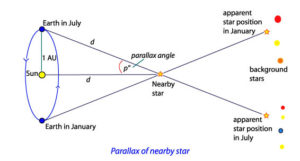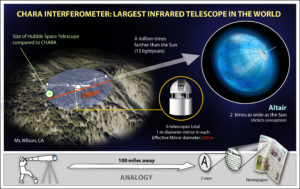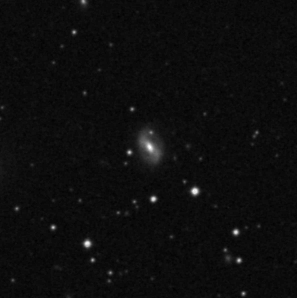Mar
24
Measuring Astronomical Distances
“If the distances are wrong, then an object may appear small and dim not because it is incredibly distant, but because it really is small and dim. And faulty distances mean that any theory based on them — such as the big bang — is faulty too!” — Andrew Rigg, freelance journalist and amateur astronomer, writing for Creation Magazine
Back in the 1990s, when I was a regular reader/collector of many comic book titles, a new supervillain debuted at DC that was named “Parallax”. He was revealed to be Hal Jordan, the noble Green Lantern of Earth, who had somehow “gone bad”. Years later, another story revealed that “Parallax” was actually a primordial, demonic entity “made of living fear”, which had possessed Jordan and later took over Jordan’s successor, Kyle Rayner.
 Where am I going with this? The word “parallax” sounded familiar, so I (like many comic readers, I’ll bet) looked it up. As Marissa Fessenden described it in a Smithsonian article, the trigonometric parallax method “calculates distance by tracking a single celestial object’s apparent shift in position as seen from Earth’s orbit in two separate places, months apart. An easy way to imagine how this works is to hold a finger close to your face and alternate closing one eye then the other. The finger appears to move. Measuring the angle of the shift allows astronomers to calculate the distance of the object with trigonometry.”
Where am I going with this? The word “parallax” sounded familiar, so I (like many comic readers, I’ll bet) looked it up. As Marissa Fessenden described it in a Smithsonian article, the trigonometric parallax method “calculates distance by tracking a single celestial object’s apparent shift in position as seen from Earth’s orbit in two separate places, months apart. An easy way to imagine how this works is to hold a finger close to your face and alternate closing one eye then the other. The finger appears to move. Measuring the angle of the shift allows astronomers to calculate the distance of the object with trigonometry.”
While the Parallax character, in its various forms, did a lot of traveling throughout the cosmos, I don’t think the name had anything to do with its powers. It just sounded cool. However, what I recently discovered is that “parallax” derives from the Greek <parallaxis> “change, alteration, inclination of two lines meeting at an angle,” from <parallassein> “to alter, make things alternate”. Given how the entity would corrupt its host, this sort of makes sense.
Of course, it’s the use of the parallax method in triangulating astronomical distances that is of relevance here. The rest was “free” for my fellow comics/superhero fans. 🙂
Direct distance measurements involve simple, plane geometry — e.g., if you know the length of the base of a triangle, then measuring the angles at the ends of that base will lead to the distance to the vertex of the triangle. There are no assumptions necessary regarding physical constants or the nature of the astronomical object at the vertex. Historically, astronomers have used the diameter of the Earth’s orbit as the triangle’s base to make Earth-based, trigonometric parallax measurements. No problem there, but accurate direct measurements have therefore been limited to stars a few hundred light-years away. They have then been used to calibrate indirect measurements reaching far out into space.
Young Earth Creationists (YEC) apparently only trust direct measurements, so for many years they have challenged the validity of these indirect measurements out to distant stars and galaxies and, therefore, of any subsequent inferences regarding the age of the universe. But, two developments in the past couple decades have made such objections moot. The first is the use of very long baseline interferometry, which has increased our telescopic power well beyond that of optical telescopes a few tens of feet in diameter. Now, an array of radio telescopes linked together produces “the angular resolving power of a telescope thousands of miles in diameter.” Radio astronomers have been able to get direct measurements to pulsars and planetary nebulae many thousands of light-years away.
The second development is that astronomers can now use other, much longer things for the triangle’s base — e.g., the diameter of a star’s orbit around another star, the diameter of a maser source’s orbit around a galaxy’s central supergiant (nearly a million times the length of the diameter of the Earth’s orbit), or the diameter of a shell of gas exploded from a supernova. As a result, direct triangulation measurements have been made to the centers of several galaxies: Milky Way Galaxy (26,000 light-years), Large Magellanic Cloud (160,000 light-years), NGC 4258 (23.5 million light-years), NGC 1637 (24.6 million light-years), M100 (54 million light-years), UGC 3789 (162 million light-years), NGC 6264 (470 million light-years). If that weren’t enough, a similar measurement puts the quasar 3C 279 at 5.9 billion light-years away.
Indirect distance-measuring methods, such as the redshifts of spectral lines and the brightness of “standard candle stars” (e.g., Type Ia supernovae and Cepheid variable stars), have been sufficiently well calibrated by the above direct methods that there is really no good reason to question their reliability. In A Matter of Days (2015) (the basis for much of this article), Dr. Hugh Ross states,
“Astronomers still argue over which indirect method is the most reliable, but direct-method calibrations keep the uncertainties of indirect methods below 5 percent….
These measurements confirm the accuracy of redshift measurements indicating the distance and cosmic expansion velocity of ancient galaxies and quasars.”
But, wait! There’s more…
In an article earlier this year, Ross discussed new research printed in the Astrophysical Journal that may significantly shrink the 5% margin of error. In short, an international team of 21 astronomers announced they had achieved the most accurate direct distance measurement to date for a Cepheid variable star — specifically, a binary named ‘V1334’. They used the Michigan Infrared Combiner (MIRC) installed at the Center for High Angular Resolution Astronomy (CHARA) located on Mount Wilson in California, which provides angular resolving power of 0.2 milliarcseconds. That’s more than 50x better than the best-achievable resolution of the Hubble Space Telescope.
 The result: a distance measurement to V1334 accurate to +/- 1 percent. It was also the first time that a binary Cepheid star was resolved both spatially and spectroscopically.
The result: a distance measurement to V1334 accurate to +/- 1 percent. It was also the first time that a binary Cepheid star was resolved both spatially and spectroscopically.
Ross concludes his article,
“An important caveat noted by the team of 21 is that the companion star is sufficiently close to V1334 as to make separating its light contribution from that of V1334 challenging. Thus, it is premature to claim that a factor of five improvement in cosmic creation models has been achieved. Hence, the team calls for more MIRC observations of the V1334 system and to use MIRC to make observations on other binary star systems.
Nevertheless, these 21 astronomers have demonstrated through their measurements that very-high-precision cosmology is just around the corner. Such high-precision cosmology has the potential to deliver ever stronger evidence for the biblically predicted cosmic creation model.”
Of course, YECs need to hold onto their model and will typically counter with other “challenges”, including various theories about how light works (and/or used to work) differently than is generally recognized. But, those theories are fraught with many more problems than the ones they claim non-YECs have. (Ross addresses several in A Matter of Days.)
P.S. Though he didn’t write it as such, the following quote from Ross might serve as a response to Rigg’s quote at the top of this post:
“Star size represents another consideration — an important one in this question of true distances. If all stars really are near rather than distant, their faintness would indicate that many are tiny — much tinier than the minimum size necessary for stars to burn. If stars were not distant and yet large enough to burn, another problem would be evident: a ‘night’ sky as bright as day — fine for angelic creatures, perhaps, but deadly for earthly ones and certainly not the condition of Earth’s sky.”
















